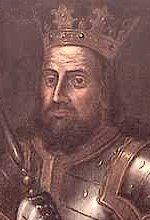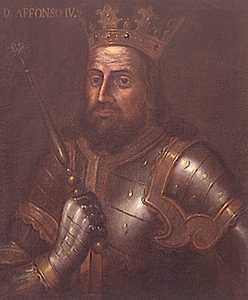Predecessor Denis Name Afonso of Issue See descendants | Successor Peter I | |
 | ||
Reign 7 January 1325 – 28 May 1357 Children Peter I of Portugal, Maria of Portugal, Queen of Castile, Eleanor of Portugal, Queen of Aragon Parents Denis of Portugal, Elizabeth of Aragon Siblings Afonso Sanches, Lord of Albuquerque Similar People Peter I of Portugal, Afonso III of Portugal, Ines de Castro, Afonso V of Portugal, Denis of Portugal | ||
Afonso IV of Portugal
Afonso IV ([ɐˈfõsu]; 8 February 1291 – 28 May 1357), called the Brave (Portuguese: o Bravo), was King of Portugal and the Algarves from 1325 until his death. He was the only legitimate son of King Denis of Portugal by his wife Elizabeth of Aragon.
Contents
- Afonso IV of Portugal
- Early life
- King of Portugal and Algarve
- Later life
- Marriage and descendants
- References

Afonso IV of Portugal
Early life

Afonso, born in Lisbon, was the rightful heir to the Portuguese throne. However, he was not Denis' favourite son, the old king preferring his illegitimate son, Afonso Sanches. The notorious rivalry between the half brothers led to civil war several times. On 7 January 1325, Afonso's father died and he became king, whereupon he exiled his rival to Castile, and stripped him of all the lands and fiefdom given by their father. From Castile, Afonso orchestrated a series of attempts to usurp the crown. After a few failed attempts at invasion, the brothers signed a peace treaty, arranged by Afonso's mother Queen Elizabeth.
In 1309, Afonso IV married Infanta Beatrice of Castile, daughter of King Sancho IV of Castile by his wife María de Molina. The first-born of this union was Infanta Maria of Portugal.
King of Portugal and Algarve
In 1325 Alfonso XI of Castile entered a child-marriage with Constanza Manuel of Castile, the daughter of one of his regents. Two years later, he had the marriage annulled so he could marry Afonso's daughter, Maria of Portugal. Maria became Queen of Castile in 1328 upon her marriage to Alfonso XI, who soon became involved publicly with a mistress. Constanza was imprisoned in a castle in Toro while her father, Juan Manuel, Prince of Villena, waged war against Alfonso XI until 1329. Eventually, the two reached a peaceful accord after mediation by Juan del Campo, Bishop of Oviedo; this secured Constance's release from prison.
The public humiliation of his daughter led Afonso IV to have his son and heir, Peter, marry the no less aggrieved Castilian infanta, Constanza. Afonso subsequently started a war against Castile, peace arriving four years later, through the intervention of the Infanta Maria herself. A year after the peace treaty was signed in Seville, Portuguese troops played an important role in defeating the Moors at the Battle of Río Salado in October 1340.
Later life
Political intrigue marked the last part of Afonso IV's reign, although Castille was torn by civil war after Alfonso XI died. Henry of Trastámara challenged the new King Pedro of Castile, who sent many Castilian nobles into exile in Portugal. Afonso's heir, Pedro, fell in love with his new wife's lady-in-waiting, Inês de Castro. Inês was the daughter of an important noble family from Galicia, with links (albeit illegitimate) to both the royal houses of Castile and Portugal. Her brothers were aligned with the Trastamara faction, and became favorites of crown prince Pedro, much to the dismay of others at the Portuguese court, who considered them Castilian upstarts. When Constance of Peñafiel died weeks after giving birth to their third child, Pedro began living openly with Inês, recognized all her children as his and repudiated the idea of marrying anyone other than Inês herself. His father refused to go to war again against Castile, hoping his heir's infatuation would end, and tried to arrange another dynastic marriage for Pedro.
The situation became worse as the years passed and the aging Afonso lost control over his court. His grandson and Pedro's only legitimate son, future king Fernando of Portugal, was a sickly child, while Inês' illegitimate children thrived. Worried about his legitimate grandson's life, and the growing power of Castile within Portugal's borders, Afonso ordered Inês de Castro first imprisoned in his mother's old convent in Coimbra, and then murdered in 1355. He expected his son to give in and marry a princess, but the heir became enraged upon learning of his lover's decapitation in front of their young child. Pedro put himself at the head of an army and devastated the country between the Douro and the Minho rivers before he was reconciled to his father in early 1357. Afonso died almost immediately after, in Lisbon in May.
Afonso IV's nickname the Brave alludes to his martial exploits. However, his most important accomplishments were the relative peace enjoyed by the country during his long reign and the support he gave to the Portuguese Navy. Afonso granted public funding to raise a proper commercial fleet and ordered the first Portuguese maritime explorations. The conflict with Pedro, and the explorations he initiated, eventually became the foundation of the Portuguese national epic, Os Lusíadas by Luís de Camões.
The dramatic circumstances of the relationship between father and son and Inês de Castro was used as the basis for the plot of more than twenty operas and ballets, as well as the "Nise lastimosa" and "Nise laureada" (1577) by Jerónimo Bermúdez, 'Reinar despues de morir' by Luís Vélez de Guevara, "Inez de Castro" by Mary Russell Mitford, and La Reine morte (The Dead Queen) by Henry de Montherlant. The story with its tragic denouement is immortalized in several plays and poems in Portuguese, such as The Lusíadas by Luís de Camões (canto iii, stanzas 118-135), and in Spanish, including Nise lastimosa and Nise laureada (1577) by Jerónimo Bermúdez, Reinar despues de morir by Luís Vélez de Guevara, as well as a play by French playwright Henry de Montherlant called La Reine morte (The Dead Queen). Mary Russell Mitford also wrote a drama based on the story entitled Inez de Castro. Inês de Castro is a novel by Maria Pilar Queralt del Hierro in Spanish and Portuguese.
Marriage and descendants
On 12 September 1309, Afonso married Beatrice of Castile, daughter of Sancho IV of Castile, and María de Molina, and had four sons and three daughters. Afonso broke the tradition of previous kings and did not have any children out of wedlock.
